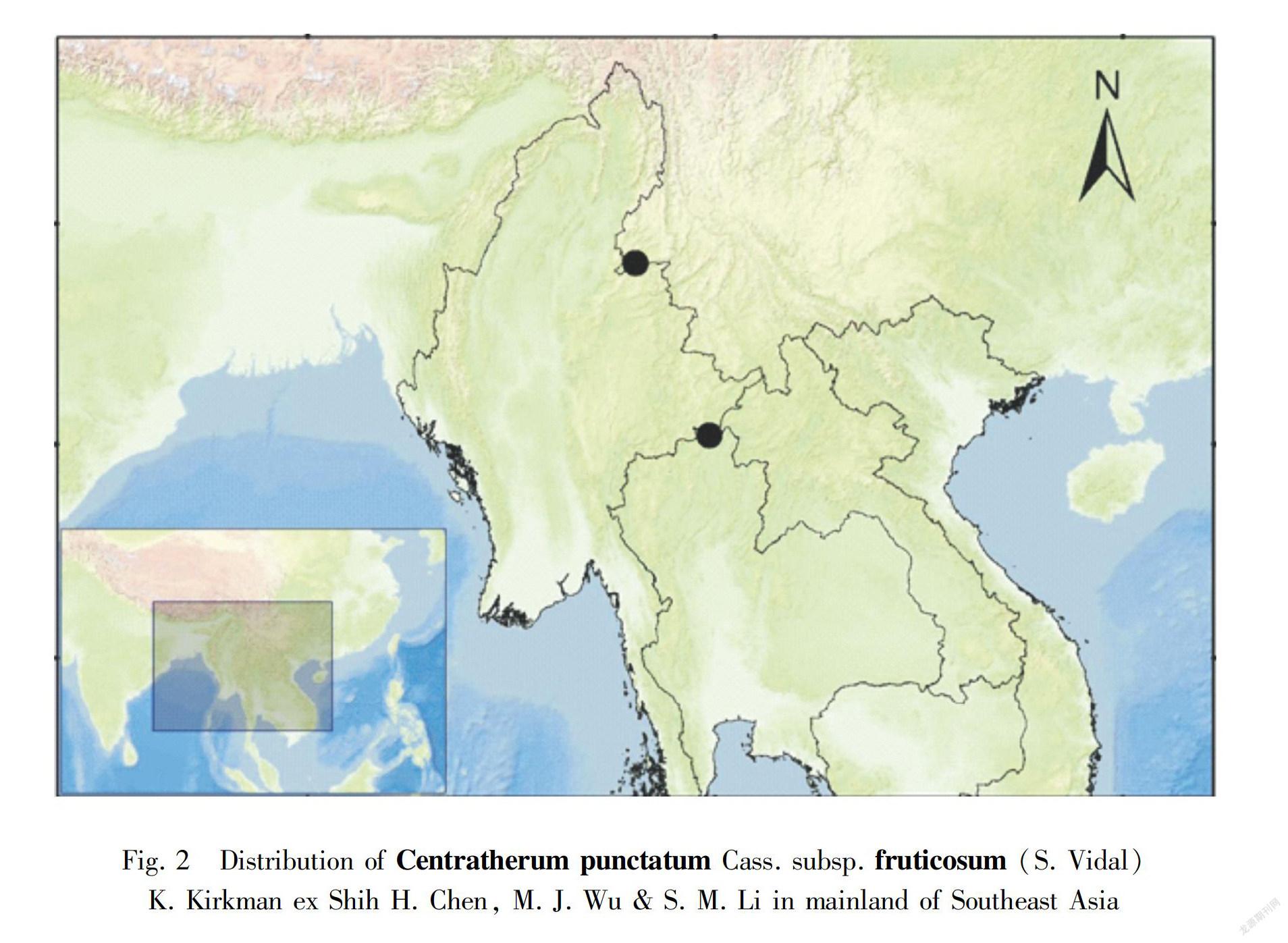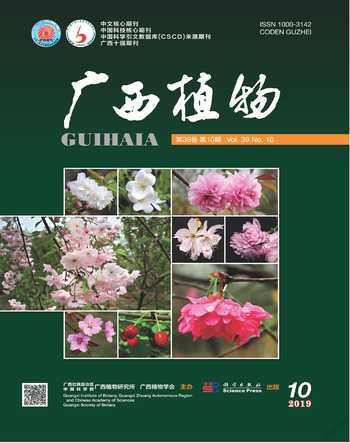苹果蓟属,东南亚大陆菊科一新归化属
2019-09-10沈佳豪牛帼豪张国进付志玺INTAAngkhana高天刚
沈佳豪 牛帼豪 张国进 付志玺 INTA Angkhana 高天刚


摘 要:該文报道了在泰国北部和中国西南部的菊科一个新归化属——苹果蓟属(Centratherum Cass.)。依据所采集的标本,详细描述了该属在东南亚大陆的唯一代表亚种苹果蓟 [Centratherum punctatum Cass. subsp. fruticosum (S. Vidal) K. Kirkman ex Shih H. Chen, M. J. Wu & S. M. Li],并配以插图。苹果蓟与其所在属的其他种的区别在于该亚种叶片菱形至椭圆形,叶缘具不规则锯齿,先端微尖,总苞片基部硬化,先端无芒。文中还提供了苹果蓟的分布图,并讨论了其可能的传播途径。
关键词: 苹果蓟属, 菊科, 斑鸠菊族, 归化属, 东南亚大陆, 命名法
In a field trip to Thailand in May 2014, we collected an unknown taxon of the tribe Vernonieae of Aste-raceae. Similar specimens were also collected in an expedition to Yunnan, China in April 2017. We identified these specimens as Centratherum punctatum Cass. subsp. fruticosum (S. Vidal) K. Kirkman ex Shih H. Chen, M. J. Wu & S. M. Li, a genus and a subspecies not previously recorded in the mainland of Southeast Asia. Centratherum Cass. but a tropical genus distributed in tropical America, Australia and Philippines (Kirkman, 1981). C. punctatum subsp. fruticosum is native to Philippines and can be distinguished from the other taxa of this genus by its leaf blade rhombic to elliptic, leaf margins irregularly serrate, leaf apex broadly acute, and phyllaries indurate at base and not awned (Kirkman, 1981; Chen et al., 1999).
Based on the specimens collected during the flo-wering phase, we provided the description as below.
Centratherum punctatum Cass. subsp. fruticosum (S. Vidal) K. Kirkman ex Shih H. Chen, M. J. Wu & S. M. Li in Taiwania 44(2): 300. 1999 (Figs. 2-4).
≡Centratherum fruticosum S. Vidal, Rev. Pl. Vasc. Filip. 159. 1886; Elmer in Leafl. Philip. Bot. 1: 88. 1906.
Type: —PHILIPPINES. Distr. Lepanto (Mt. Province), 1876, S. Vidal 1502 (syntypes: A photo![No. A00004641], L photo![No. L.3034111], MA photo![No. MA728008]).
=Centratherum punctatum Cass. subsp. fruticosum (Elmer) K. Kirkman in Rhodora 83: 20. 1981, nom. inval.
Type: —PHILIPPINES. Prov. Batangas, Luzon, 1841, H. Cuming 1556 (lectotype (designated by Kirkman, 1981): G photo![No. G00223244]; isolectotypes: E photo![No. E00417342], K photo![No. K000796695], LE photo![No. LE00017869, LE00017870]).
Perennial herbs or subshrubs, up to 1-1.4 m tall, branched (Fig.1: A). Stem woody glabrous at base, young shoot hirsute, ridged. Leaves crowded, short internodes often appear fascicled, leaf blade elliptic-obovate to rhombic, 1-8.3 × 0.5-3.9 cm, broadly acute at apex, attenuate to truncate at base, margin irregularly crenate-serrate, uniseriate and T-shaped trichomes on both surfaces; petiole up to 2 cm, winged, indistinct in small blades. Capitula terminal or terminal on axillary branches, 2-2.8 cm in diam., 1.8-2 cm tall; peduncle 3-11 cm long, pubescent, receptacle naked; involucre campanulate to sub-globose, ca. 1 cm tall, base with leafy whorled bracts; phyllaries imbricate in 5-7 series, minutely pubescent, 3-veined, inner phyllaries linear-oblanceolate to fiddle-shaped, 8 × 2.5-2.7 mm, apex mucronate to cuspidate, margin scarious, outer phyllaries triangular, 5-7 × 1-1.2 mm, apex spine or acuminate, base indurate (Fig.1: B). Capitulum with many florets, hermaphrodite, regular. Corolla tubular, reddish-purple, 8-16 mm long, outer part with glandular hairs, lobes 5, linear-lanceolate (Fig.1: C). Style white, style-branches filiform, flushed with purple and hispidulous (Fig.1: D). Stamens 5, white; anthers linear, 3 × 0.5 mm, appendant lanceolate, base calcarate (Fig.1: E). Achene obconic-cyclindrical, ca. 2.5 × 1.5 mm, black, glabrous, with 10 ribs. Pappus of 6-10 bristles, deciduous, straw-colored, 2-3 × 0.2 mm.
Phenology: Flowering and fruiting throughout the years.
Specimens examined: THAILAND. Chiang Mai: Maesai to Nan, alt. 364 m, 99°51′32″ E, 20°12′17″ N, 14 May 2014, Tiangang GAO & Guojin ZHANG 5807 (PE). CHINA. Yunnan: Dehong Autonomous Prefecture, Ruili City, Wanding Town, Huihuan Village, alt. 935 m, 98°2′40″ E, 24°7′4″ N, 1 April 2017, Jinpu WEI et al. RL0832 (HCNGB). (Fig. 2)
In Asia, Centratherum punctatum Cass. subsp. fruticosum (S. Vidal) K. Kirkman ex Shih H. Chen, M. J. Wu & S. M. Li was recorded in Taiwan (Chen et al., 1999) and West Bengal (Chowdhury & Das, 2012). But it has never been recorded in the mainland of Southeast Asia. Besides the present distribution sites (Southwest China and North Thailand), it could also possibly be discovered in the nearby places (like Myanmar) in the future. It may be dispersed to the continent of Southeast Asia by flower trade, as marketing information about it can be obtained in two big business websites of China (Jingdong, 2018; Taobao, 2018). Hitherto, C. punctatum subsp. fruticosum has not been reported as an invasive species. However, based on our field observations, it could produce an immense number of mature achenes (ca. 150) in one capitulum. In addition, because of the vegetational and climatic similarities between mainland of Southeast Asia and origin distribution (Zhang et al., 2017), close attention should be paid to its potential dispersal.
Note:Centratherum fruticosum was validly published by Vidal (1886) with indicating a single gathering (Vidal 1502). Quisumbing (1958, in sched.) labeled one specimen of this gathering (MA[No. MA728008]) as “type”, the other (A[No. A00004641] as “isotype”, but no effective publication was found. According to Art 7.9 and 9.5 of ICN (McNeill et al., 2012), these three specimens from a single gathering should be treated as syntypes. In 1906, Elmer used the name C. fruticosum S. Vidal by giving a full and direct refe-rence, and cited the specimens Cuming 1556 and Elmer 5956. In 1981 Kirkman established the new combination C. punctatum Cass. subsp. fruticosum (Elmer) K. Kirkman based on the incorrect author and reference citation. In addition, Kirkman designated Cuming 1556 (G[No. G00223244]) as lectotype of C. punctatum Cass. subsp. fruticosum (Elmer) K. Kirkman and described it only in English. According to the Art 39.1, 41.5 and 41.8(d) of ICN (McNeill et al., 2012), as a new taxon name, C. punctatum subsp. fruticosum K. Kirkman was invalidly published because of no Latin description or diagnosis. Hence, the new combination C. punctatum subsp. fruticosum (Elmer) K. Kirkman was invalidly published because of the indirect reference. In 1999, Chen et al. cited Kirkman’s publication but clearly indicated the correct basionym C. fruticosum S. Vidal with a full and direct reference. Hence, C. punctatum Cass. subsp. fruticosum (S. Vidal) K. Kirkman ex Shih H. Chen, M. J. Wu & S. M. Li was the valid name. The result is coincident with that of Chowdhury & Das (2012).
Acknowledgements We are indebted to the curators of the herbarium PE and HCNGB for access to specimens.
References:
CHEN SH, WU MJ, LI SM, 1999. Centratherum punctatum Cass. ssp. fruticosum, a newly naturalized sunflower species in Taiwan [J]. Taiwania, 44: 299-305.
CHOWDHURY M, DAS AP, 2012. Record of naturalization of Centratherum punctatum Cassini ssp. fruticosum (S. Vidal) K. Kirkman (Asteraceae) in India with a note on its nomenclature [J]. J Bot Soc Bengal, 66: 69-71.
ELMER ADE,1906. Manual of the Philippine Compositae [J]. Leafl Philip Bot, 1: 83-186.
JINGDONG, 2018[2018-07-01].[EB/OL]. https://item.jd.com/24598283886.html.
KIRKMAN LK,1981. Taxonomic revision of Centratherum and Phyllocephalum (Compositae: Vernonieae) [J]. Rhodora, 83: 1-24.
MCNEILL J, BARRIE FR, BUCK WR, et al., 2012. International Code of Nomenclature for algae, fungi, and plants (Melbourne Code) adopted by the Eighteenth International Botanical Congress Melbourne, Australia, July 2011 (Regnum Vegetabile 154) [M]. Knigstein: Koeltz Scientific Books.
TAOBAO, 2018[2018-07-01].[EB/OL]. http://m.tb.cn/h.WuTJpcx.
VIDAL S, 1886. Revision de plantas vasculares Filipinas [M]. Manila: Establecimiento Tipo-Litográfico de M. Perze: 159.
ZHANG X, WU S, YAN X, et al., 2017. A global classification of vegetation based on NDVI, rainfall and temperature [J]. Int J Climatol, 37: 2318-2324.
